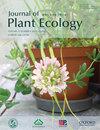Multitrophic biodiversity enhances ecosystem functions, services and ecological intensification in agriculture
IF 3.9
2区 环境科学与生态学
Q2 ECOLOGY
引用次数: 4
Abstract
One central challenge for humanity is to mitigate and adapt to an ongoing climate and biodiversity crisis while providing resources to a growing human population. Ecological intensification aims to maximise crop productivity while minimizing impacts on the environment, especially by using biodiversity to improve ecosystem functions and services. Many ecological intensification measures are based on trophic interactions between organisms (e.g. pollination, biocontrol). Here, we investigate how research on multitrophic effects of biodiversity on ecosystem functioning could advance the application of ecological intensification measures in agriculture and forestry. We review previous studies and use qualitative analyses of the literature to test how important variables such as land-use parameters or habitat complexity affect multitrophic diversity, ecosystem functions and multitrophic biodiversity–ecosystem functioning relationships. We found that positive effects of biodiversity on ecosystem functions are prevalent in production systems, largely across ecosystem function dimensions, trophic levels, study methodologies and different ecosystem functions, however, with certain context-dependencies. We also found strong impacts of land use and management on multitrophic biodiversity and ecosystem functions. We detected knowledge gaps in terms of data from underrepresented geographical areas, production systems, organism groups and functional diversity measurements. Additionally, we identified several aspects that require more attention in the future, such as trade-offs between multiple functions, temporal dynamics, effects of climate change, the spatial scale of the measures and their implementation. This information will be vital to ensure that agricultural and forest landscapes produce resources for humanity sustainably within the environmental limits of the planet.多营养生物多样性增强了农业生态系统的功能、服务和生态集约化
人类面临的一个核心挑战是缓解和适应持续的气候和生物多样性危机,同时为不断增长的人口提供资源。生态强化旨在最大限度地提高作物生产力,同时最大限度地减少对环境的影响,特别是通过利用生物多样性来改善生态系统功能和服务。许多生态强化措施是基于生物之间的营养相互作用(如授粉、生物防治)。在这里,我们研究了生物多样性对生态系统功能的多营养影响,如何推动生态强化措施在农业和林业中的应用。我们回顾了以前的研究,并使用文献的定性分析来测试土地利用参数或栖息地复杂性等重要变量如何影响多营养多样性、生态系统功能和多营养生物多样性-生态系统功能关系。我们发现,生物多样性对生态系统功能的积极影响在生产系统中普遍存在,主要涉及生态系统功能维度、营养水平、研究方法和不同的生态系统功能,但存在一定的上下文依赖性。我们还发现,土地利用和管理对多营养生物多样性和生态系统功能产生了强烈影响。我们在代表性不足的地理区域、生产系统、生物群和功能多样性测量的数据方面发现了知识差距。此外,我们确定了未来需要更多关注的几个方面,如多种功能之间的权衡、时间动态、气候变化的影响、措施的空间规模及其实施。这些信息对于确保农业和森林景观在地球环境范围内可持续地为人类生产资源至关重要。
本文章由计算机程序翻译,如有差异,请以英文原文为准。
求助全文
约1分钟内获得全文
求助全文
来源期刊

Journal of Plant Ecology
生物-植物科学
CiteScore
4.60
自引率
18.50%
发文量
134
审稿时长
3 months
期刊介绍:
Journal of Plant Ecology (JPE) serves as an important medium for ecologists to present research findings and discuss challenging issues in the broad field of plants and their interactions with biotic and abiotic environment. The JPE will cover all aspects of plant ecology, including plant ecophysiology, population ecology, community ecology, ecosystem ecology and landscape ecology as well as conservation ecology, evolutionary ecology, and theoretical ecology.
 求助内容:
求助内容: 应助结果提醒方式:
应助结果提醒方式:


